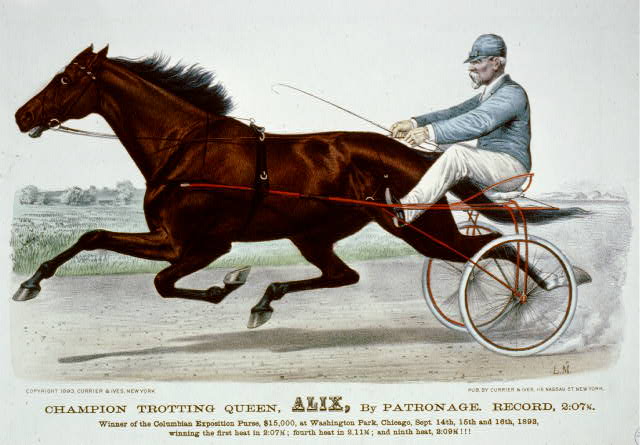Jul '15 Schock
Projects > Sweet Little Alix >

July 6, 2015
Sweet Little Alix
by Barbara Schock
Carl Sandburg was sixteen in the summer of 1894. A new racetrack had been constructed on 112 acres of land east of Farnham Street and south of Grand Avenue (Knoxville Road). It was a flat track in the shape of a figure eight, except the top of the eight was small and the long sides were straight and flat. Some called it a kite track. The curves were banked so the horses could pull their sulkies around safely at racing speeds.
Sandburg made himself useful by carrying water, running errands and helping to sponge down the sweating horses after their runs. He was usually given a tip of a quarter or half dollar (equal to $6 or $7 in today's money). In those hard times, the money was very useful for the Sandburg family.
Charles W. Williams had been invited by a group of local horsemen to come to Galesburg to build and manage the racetrack. He had been born in New York state December 4, 1856. His family moved to Buchanan County, Iowa, when he was eleven years old. He trained as a telegraph operator for the Illinois Central Railroad, then went to Chicago to drive a milk wagon. He returned to Independence, Iowa, and started his own business shipping milk, cream, chickens and eggs to Chicago and New York. Using horses in his business, William learned to train and handle them. He became interested in harness racing as well.
He bought four horses in 1883 for $600. He broke and trained them himself. He sent the mares Lou and Gussie Wilkes to be bred in Kentucky. Since he couldn't afford the high stud fees of the famous horses of the day, he had to make due with lesser known horses with good blood lines. Lou was bred to William L and the foal was named Axtell. Gussie Wilkes produced Allerton. Subsequently,Williams drove Allerton in record-setting times for a trotter..
Axtell set a world record on October 11, 1889, in two minutes and twelve seconds. Williams sold the stallion to a syndicate of racing men in Indiana for $105,000 (equal to more than $8.2M in 2015). Axtell was injured and never raced again. He became the sire of many great trotting horses. His descendants are racing to the present day.
Alix, the daughter of Patronage and Atlanta, was born in 1888. Williams purchased her from David Hays of Muscatine, Iowa. In her first season as a two-year old she won five of ten starts and set a record of two minutes and thirty seconds. She ran in a Free-for-all race at Washington Park near Chicago in 1893 as a five-year old. There were nine heats in the race and Alix won the $15,000 prize. It was a rugged race and Alix won the hearts of many racing fans with her staunch bravery. Her time was 2:07 3/4. Racing fans began to call her “Sweet Little Alix.”
During that week of harness racing at the Galesburg track, Alix broke the record of Nancy Hanks by a fraction of a second. Her record time of 2:03 ¾ stood until 1900. Alix died in October 1901. She produced two foals in her lifetime.
In 1908 C.W. Williams retired from horse racing and took up evangelizing in the style of Billy Sunday. He had also invested his winnings in land in Canada. At one time, he owned 33,000 acres of wheat land in Saskatchewan. He died February 2, 1936, in Aurora, Illinois.
Sandburg wrote in his autobiography, Always the Young Strangers, that he thought Williams face looked like he had secrets about handling horses and there was a solemn look that “bordered on the blank.” Others said he was a hard-working and shrewd man. He had a large capacity for work, both mental and physical, and a great deal of self-confidence.